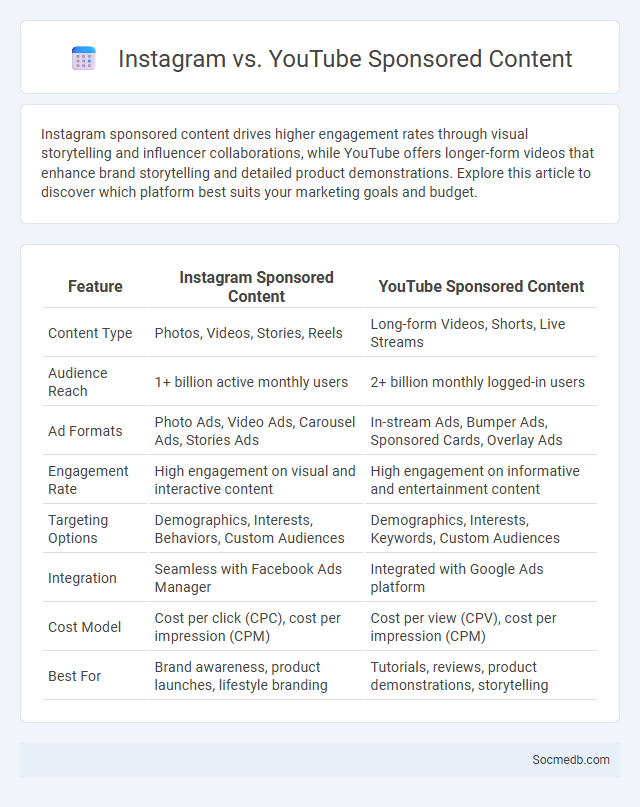
Photo illustration: Instagram vs YouTube Sponsored Content
Instagram sponsored content drives higher engagement rates through visual storytelling and influencer collaborations, while YouTube offers longer-form videos that enhance brand storytelling and detailed product demonstrations. Explore this article to discover which platform best suits your marketing goals and budget.
Table of Comparison
| Feature | Instagram Sponsored Content | YouTube Sponsored Content |
|---|---|---|
| Content Type | Photos, Videos, Stories, Reels | Long-form Videos, Shorts, Live Streams |
| Audience Reach | 1+ billion active monthly users | 2+ billion monthly logged-in users |
| Ad Formats | Photo Ads, Video Ads, Carousel Ads, Stories Ads | In-stream Ads, Bumper Ads, Sponsored Cards, Overlay Ads |
| Engagement Rate | High engagement on visual and interactive content | High engagement on informative and entertainment content |
| Targeting Options | Demographics, Interests, Behaviors, Custom Audiences | Demographics, Interests, Keywords, Custom Audiences |
| Integration | Seamless with Facebook Ads Manager | Integrated with Google Ads platform |
| Cost Model | Cost per click (CPC), cost per impression (CPM) | Cost per view (CPV), cost per impression (CPM) |
| Best For | Brand awareness, product launches, lifestyle branding | Tutorials, reviews, product demonstrations, storytelling |
Introduction to Sponsored Content: Instagram vs YouTube
Sponsored content on Instagram and YouTube plays a crucial role in influencer marketing, leveraging platforms with over 2 billion and 2.5 billion monthly active users respectively. Instagram's visual-centric format excels at quick, engaging brand stories using images and short videos, while YouTube's long-form video content fosters deeper audience connection and product demonstration. Brands prioritize Instagram for lifestyle branding and YouTube for detailed reviews, maximizing ROI through tailored content strategies in sponsored campaigns.
Understanding Instagram Sponsored Content
Instagram sponsored content leverages targeted advertising algorithms to connect brands with specific audience demographics based on user behavior and interests. This form of paid promotion allows businesses to enhance visibility and engagement through native ads seamlessly integrated into users' feeds and stories. Effective sponsored content combines compelling visuals with clear calls-to-action to drive traffic, increase brand awareness, and boost conversion rates.
Exploring YouTube Sponsored Content
YouTube sponsored content integrates brand advertising seamlessly within creators' videos, enhancing viewer engagement through authentic storytelling and targeted promotion. Leveraging algorithms and user data, these sponsored videos optimize reach by connecting brands with niche audiences interested in specific content categories. This form of social media marketing boosts brand visibility and drives conversion rates by combining influencer credibility with YouTube's vast global user base.
Key Differences: Instagram vs YouTube Sponsored Content
Instagram sponsored content emphasizes visually compelling images and short videos optimized for quick engagement and mobile viewing, leveraging Stories and Reels features for immersive, time-sensitive campaigns. YouTube sponsored content prioritizes longer-form video advertisements and in-depth storytelling, allowing brands to create detailed tutorials, reviews, and unboxing experiences that drive higher viewer retention and brand trust. Performance metrics differ, with Instagram focusing on reach, impressions, and engagement rate, while YouTube evaluates watch time, click-through rates, and subscriber growth.
Audience Engagement: Instagram vs YouTube Sponsorships
Instagram sponsorships drive higher audience engagement through interactive features such as Stories, polls, and direct messaging, enabling brands to connect personally with followers. YouTube sponsorships benefit from long-form content that fosters in-depth storytelling and detailed product demonstrations, which build trust and audience loyalty. Brands targeting quick, visual interactions prefer Instagram, while those emphasizing comprehensive content and community-building leverage YouTube for sponsorship success.
Content Formats: Visuals and Videos Compared
Visual content on social media, including images and infographics, typically generates higher engagement rates as users quickly absorb information without reading long texts. Videos, on the other hand, provide dynamic storytelling opportunities that increase viewer retention and encourage shares, making them ideal for brand awareness and deep connection. Your strategy should balance striking visuals with compelling video content to maximize reach and audience interaction across platforms.
Influencer Collaboration Strategies
Influencer collaboration strategies hinge on identifying niche-specific creators with high engagement rates to maximize brand visibility and authenticity. Data-driven approaches such as analyzing audience demographics and content performance metrics ensure partnerships align with target market behavior and preferences. Implementing structured contracts with clear deliverables and performance KPIs drives accountability and measurable ROI in influencer marketing campaigns.
Measuring Sponsored Content ROI on Both Platforms
Measuring sponsored content ROI on social media platforms like Instagram and Facebook requires analyzing engagement metrics, click-through rates, and conversion tracking through built-in analytics tools. You should leverage platform-specific features such as Facebook Pixel and Instagram Insights to gather accurate data and optimize your ad spend. Understanding the cost-per-acquisition and return on ad spend helps you refine campaigns and maximize your investment.
Brand Suitability: Choosing Between Instagram and YouTube
Brand suitability depends on your target audience and content style, with Instagram excelling in visual storytelling and quick engagement through photos and short videos. YouTube offers longer video formats, ideal for in-depth tutorials, product reviews, and building a loyal subscriber base. Evaluating your brand goals and user behavior on each platform ensures your marketing strategy maximizes reach and engagement.
Future Trends in Sponsored Content Marketing
Emerging technologies like AI and augmented reality are revolutionizing sponsored content marketing by enabling hyper-personalized and immersive brand experiences. Platforms such as TikTok and Instagram are enhancing algorithmic targeting, allowing your campaigns to reach highly specific and engaged audiences with greater precision. Influencer collaborations will increasingly leverage authentic storytelling supported by data analytics to maximize ROI and audience trust.
 socmedb.com
socmedb.com